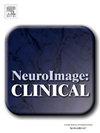Cortical morphological alterations in adolescents with major depression and non-suicidal self-injury
IF 3.6
2区 医学
Q2 NEUROIMAGING
引用次数: 0
Abstract
Background
Non-suicidal self-injury (NSSI) involves repetitive self-harm without suicidal intent and is common among adolescents, often linked to major depressive disorder (MDD). NSSI can lead to physical harm, cognitive impairments, interpersonal issues, violent behavior, and increased risks of psychological disorders and suicide attempts later in life.
Methods
Voxel-based morphometry (VBM) and surface-based morphometry (SBM) were performed on 44 NSSI patients and 44 healthy controls (HCs). Differences in GMV, CT, and cortical complexity were compared using the two-sample t-tests and correlated with neuropsychological scales.
Results
NSSI patients exhibited significant GMV atrophy in multiple regions, including the left insula, left anterior cingulate cortex, left putamen, left middle frontal gyrus, and right superior frontal gyrus showing increased GMV in the cerebellum posterior lobe. NSSI patients had increased CT in multiple left hemisphere regions and decreased CT in the right middle frontal gyrus. Additionally, they exhibited reduced cortical complexity, including decreased SD in the right frontal gyrus, and lower GI in the left insula. There were no significant differences between the two groups in terms of fractal dimension (FD). NSSI patients showed negative correlation between the CT of the right middle frontal gyrus and the anger dimension of the BPAQ, as well as the SD of the right superior frontal gyrus and the hostility dimension of the BPAQ.
Conclusion
NSSI patients have significant structural changes in the insular cortex, prefrontal cortex, precentral and postcentral gyrus, temporal lobe, putamen, and anterior cingulate cortex, offering a morphological perspective on the pathophysiology of NSSI in MDD.
重度抑郁症和非自杀性自伤青少年的皮质形态学改变。
背景:非自杀性自残(NSSI)是指没有自杀意图的重复性自残行为,在青少年中很常见,通常与重度抑郁障碍(MDD)有关。NSSI 可导致身体伤害、认知障碍、人际关系问题、暴力行为,并增加日后患心理障碍和企图自杀的风险:方法:对 44 名 NSSI 患者和 44 名健康对照组(HCs)进行了基于体素的形态测量(VBM)和基于表面的形态测量(SBM)。采用双样本 t 检验比较了 GMV、CT 和皮质复杂性的差异,并将其与神经心理学量表进行了相关分析:NSSI患者在多个区域表现出明显的GMV萎缩,包括左侧岛叶、左侧扣带回前皮层、左侧普坦门、左侧额中回和右侧额上回,显示小脑后叶的GMV增加。NSSI 患者左半球多个区域的 CT 增加,而右侧额中回的 CT 减少。此外,他们还表现出皮质复杂性降低,包括右侧额回的 SD 值降低和左侧岛叶的 GI 值降低。两组患者在分形维度(FD)方面没有明显差异。NSSI患者右侧额叶中回的CT与BPAQ的愤怒维度呈负相关,右侧额叶上回的SD与BPAQ的敌意维度呈负相关:结论:NSSI患者的岛叶皮层、前额叶皮层、中央前回和中央后回、颞叶、普坦门和扣带前皮层的结构发生了明显变化,这为MDD患者NSSI的病理生理学提供了一个形态学视角。
本文章由计算机程序翻译,如有差异,请以英文原文为准。
求助全文
约1分钟内获得全文
求助全文
来源期刊

Neuroimage-Clinical
NEUROIMAGING-
CiteScore
7.50
自引率
4.80%
发文量
368
审稿时长
52 days
期刊介绍:
NeuroImage: Clinical, a journal of diseases, disorders and syndromes involving the Nervous System, provides a vehicle for communicating important advances in the study of abnormal structure-function relationships of the human nervous system based on imaging.
The focus of NeuroImage: Clinical is on defining changes to the brain associated with primary neurologic and psychiatric diseases and disorders of the nervous system as well as behavioral syndromes and developmental conditions. The main criterion for judging papers is the extent of scientific advancement in the understanding of the pathophysiologic mechanisms of diseases and disorders, in identification of functional models that link clinical signs and symptoms with brain function and in the creation of image based tools applicable to a broad range of clinical needs including diagnosis, monitoring and tracking of illness, predicting therapeutic response and development of new treatments. Papers dealing with structure and function in animal models will also be considered if they reveal mechanisms that can be readily translated to human conditions.
 求助内容:
求助内容: 应助结果提醒方式:
应助结果提醒方式:


